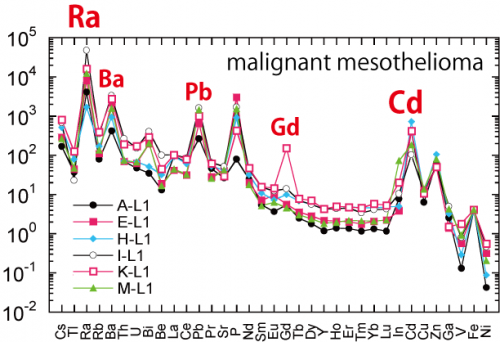Accumulation of radium in ferruginous protein bodies formed in lung tissue
Although exposures to fibers and particles have been proposed to be associated with several different lung malignancies including mesothelioma, the mechanism for the carcinogenesis is not fully understood. We have analyzed extracted asbestos bodies (fibers and proteins attached to them) with coexisting fiber-free ferruginous protein bodies from extirpative lungs of patients with malignant mesothelioma. The geochemical analysis suggests that inhaled iron-rich asbestos and dust, and excess iron deposited by continuous cigarette smoking would induce ferruginous protein body formation resulting in ferritin aggregates in lung tissue. The ferruginous protein bodies showed anomalously high concentrations of radioactive radium, reaching millions-times higher concentration than that of seawater. Hotspot ionizing radiation from radium and its daughter nuclides may cause DNA damage in lung tissue, initiate different types of tumour cells, including malignant mesothelioma cells, and may cause cancers. The onset of cancer can be determined by exposure to iron-rich particles, numbers of particles accumulated over time, development of ferritin-ferrihydrite, and accumulation of Ra in ferruginous protein body in lung.

References:
- Eizo Nakamura, Akio Makishima, Kyoko Hagino, Kazunori Okabe. Accumulation of radium in ferruginous protein bodies formed in lung tissue: association of resulting radiation hotspots with malignant mesothelioma and other malignancies, Proceedings of the Japan Academy, Series B, 85(7), 229-239 (2009). doi:10.2183/pjab.85.229, dream/20100403102548547.admin.